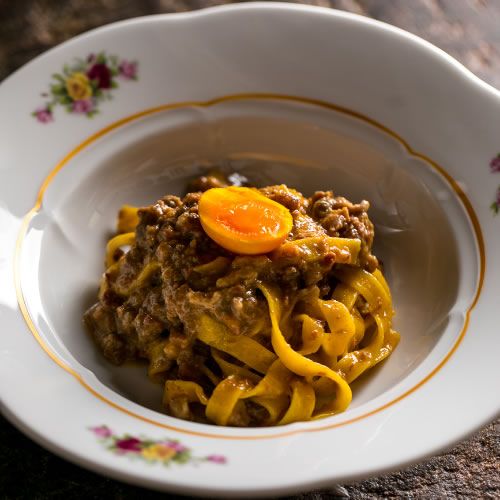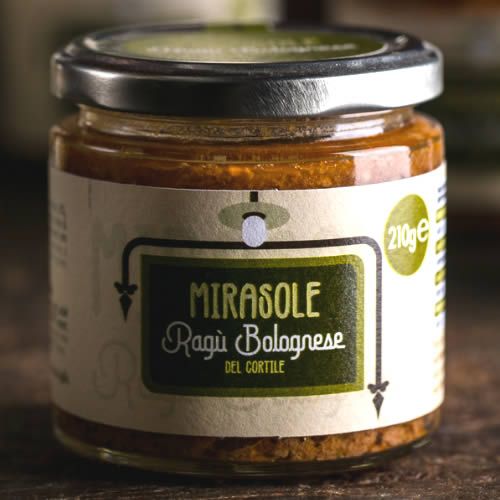CONTACTS 051.821273 | Via Giacomo Matteotti 17, 40017 - San Giovanni in Persiceto (BO)
Courtyard Meat Sauce By Franco Cimini
Born from an essential need not to waste absolutely anything, this countryside meat sauce tells of lives sacrificed to work in the fields and the satisfaction of being at the table with loved ones in front of a very poor, but very tasteful dish.
Origin Of The Courtyard Meat Sauce:
Teased by a singular battle that sees us in continuous debate with the so-called "Bolognese" meat sauce (today so widely and improperly proposed in menus all over the world as spaghetti with bolognese sauce), several years ago we undertook an accurate and thorough research that has led us to indisputable conclusions today.
If it is true that the name ragù is borrowed from the French ragout, introduced in Italy by Napoleon the third, the only connection with that preparation is the etymology of the word, as it was made of large cuts of meat cooked for a long time to serve a single dish.
Meat sauce in the territory of Bologna, on the other hand, superbly seasons egg pasta rigorously rolled out with a rolling pin and, above all, tagliatelle.
The countryside of Persiceto claim the authorship of this ancient meat sauce. Living testimonies, ancient writings and still vivid custom in the homes of housewives over eighty years of age prove it.
The prized pork and cow meats were sold to use the proceeds to support the large family; the less noble cuts remained, such as the fifth quarter and offal.
It was therefore here that with great ingenuity and wisdom, "the ARZDOURA" (ruler of the house) made a virtue of necessity. Having to “put into work” (use) and possibly make tasty what little she had available, she managed to create a masterpiece of flavours and textures: the SAUTÉED.
She alone, in the large pocket of her apron, had the key to the pantry where food supplies were kept for the whole year, including lard and a little stretched bacon (salted for storage).
In the bottom of the copper and tin pot, she put a few cubes of lard to flavour the hand-chopped onion, celery and carrot. Little, indeed very little, was the beef, mostly from the forequarter, coarsely pounded and added.
She then used all the offal and entrails of the slaughtering of farmyard animals, and therefore durelli, hearts, crests and wattles, livers and ovaries (egg in the embryonic state when it is still in the belly of the hen), which she added according to the different times of cooking. Thus the rural sauce was born, an ancient country sauce, very low in cost but very rich in terms of taste!
At noon, on the long wooden tables, to cheer the numerous diners and relieve the fatigue of hard work in the fields, the COURTYARD MEAT SAUCE TAGLIATELLA reigned steaming!
Only later, the meat sauce reached the rich tables of the city, and was refined by eliminating the offal and embellished by replacing the lard with raw ham for the bottom and abounding with fine-cut beef.
The Osteria del Mirasole, for an innate strong link with the authentic flavours of tradition, thrills countless customers with its tagliatelle with ancient Persiceto courtyard meat sauce, cultural heritage of our lowlands, of inestimable value.
Bolognese sauce. Ingredients: meat broth (water, 14% adult beef, onion, salt) adult beef, PDO Parma Ham (pork, salt), pork, chicken (11%), CELERY, carrot, sunflower oil, red wine, tomato paste, spices, salt. Keep away from heat sources. Once opened, keep refrigerated and use within 2-3 days
Book your table
Reservations are accepted by booking from the site, Instagram or Facebook.
To speak to us you can do so from 6.00pm to 7.00pm from Tuesday to Saturday.
Uncommunicated delays of more than 20 minutes will result in the cancellation of the reservation.
Opening hours
From 12PM to 3.30PM and from 7.00PM to 11.30PM.
CLOSED SUNDAY EVENING, MONDAY AND TUESDAY FOR LUNCH.
Mirasole Inn
The experience at Mirasole can pleasantly end with a stay after dinner in one of the two rooms on the upper floor, which can be accessed via a wonderful spiral staircase dating back to the 16th century.
Mirasole Experience
We want to pamper our customers with an all-round Mirasole experience, or rather, the entire supply chain! For this reason we have created a package, to enjoy or to give to people who are important to you.





Antica Osteria del Mirasole
VAT Number: 02828801205 - Telephone: +39 051.821273 | Whatsapp: open
Via Giacomo Matteotti 17/A, 40017, San Giovanni in Persiceto (BO)
All rights reserved - website created by edysma with the accessibility standards and Responsive Web Design (RWD)




